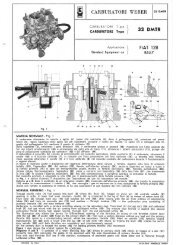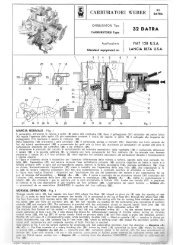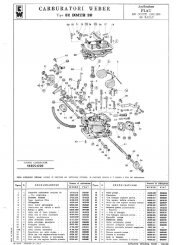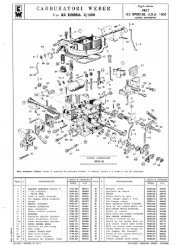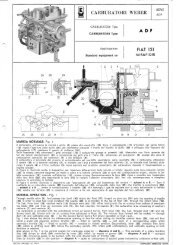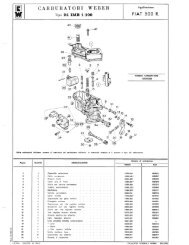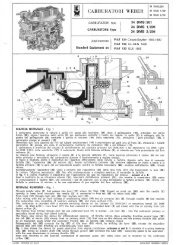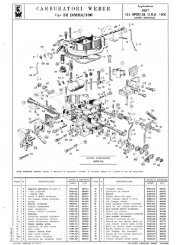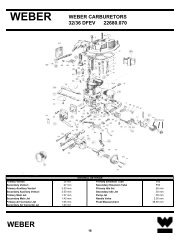Engine Maintenance and Modification Bradley Artigue
FIAT 124 Spider Engine Maintenance + Modification - Artigue.com
FIAT 124 Spider Engine Maintenance + Modification - Artigue.com
- No tags were found...
You also want an ePaper? Increase the reach of your titles
YUMPU automatically turns print PDFs into web optimized ePapers that Google loves.
FIAT 124 Spider<br />
<strong>Engine</strong> <strong>Maintenance</strong> + <strong>Modification</strong><br />
from the intake plenum <strong>and</strong> place the tip in a container. Operate the starter. The valve<br />
should spray for 1-8 seconds or while the engine coolant is under 95 degrees F. The<br />
valve should have a fine misting spray, not a drip. If the valve fails to shut off or never<br />
sprays replace the valve.<br />
Air Flow Meter<br />
The air flow sensor flap should move freely <strong>and</strong> return quickly to the closed position. The<br />
sensor must be clean. The air flow sensor is tested on the ECU connector. Unplug the<br />
ECU connector <strong>and</strong> connect an ohmmeter between terminal 6 <strong>and</strong> terminal 8.<br />
Resistance should be no more than 600 OHMS. Connect an ohmmeter between<br />
terminals 7 <strong>and</strong> 8. Resistance should be no more than 1200 OHMS. Connect an<br />
ohmmeter between terminals 8 <strong>and</strong> 9. Resistance should be no more than 350 OHMS.<br />
Oxygen Sensor<br />
Connect a voltmeter to the oxygen sensor <strong>and</strong> ground. The changes are constant - under<br />
hard acceleration <strong>and</strong> wide-open operation the sensor will read very high; under nominal<br />
operation it will cycle between 100mV <strong>and</strong> 1000mV.<br />
Auxiliary Air Regulator<br />
The auxiliary air regulator voltage can be tested by connecting a test light or volt meter to<br />
the connector poles. Voltage will be apparent when the engine is running. If voltage is<br />
not apparent replace the double relay. The air regulator may be suspect if the vehicle is<br />
idling poorly <strong>and</strong> all idle-related tests have been completed successfully.<br />
Fuel Pump <strong>and</strong> Pressure Regulator<br />
The fuel pump should never be noisy. Voltage at the pump terminals should be<br />
approximately 12V; terminals are prone to getting dirty <strong>and</strong> cleaning them may improve<br />
connectivity. Terminals should have rubber boots over them; if not consider covering<br />
connections with electrical tape or silicone. Fuel pump operation can be tested by<br />
testing the fuel line pressure in the engine compartment. Fuel feed pressure is 36 +/- 3<br />
psi with the fuel pressure regulator disconnected. Pressure is 28 psi with the regulator<br />
connected.<br />
Fuel Injectors<br />
Injectors can be tested by removing the injector <strong>and</strong> placing the nozzle in a glass<br />
container. Operate the engine <strong>and</strong> check that the fuel spray is a mist. There should be no<br />
drips. Injectors pulse during normal operation (see below). You can test the injector<br />
voltage pulse with a voltmeter or test light. Disconnect an injector plug <strong>and</strong> connect to<br />
each plug in the connector. Operate the starter (the car may or may not start) <strong>and</strong> note<br />
that voltage should pulse - making the light flicker weakly or the voltage to fluctuate. If<br />
there is no fluctuation then the ECU may be bad.<br />
55



